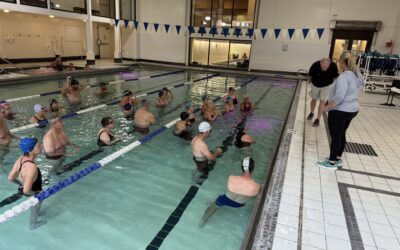As we celebrate self-care September, it’s important to review a fundamental element of healthy fitness which is often overlooked; stretching. It’s a critical component of any fitness routine, helping to keep muscles flexible, strong, and balanced. Let’s dive into why stretching is essential and explore the benefits of different types of stretching: static, dynamic, and ballistic. Discover when and with whom you can practice these types of stretches at the DAC. We’ll also break down key terms to help you understand how stretching impacts your body.
Why Stretching Matters
Stretching is about more than just loosening up tight muscles; it plays a crucial role in maintaining flexibility, improving performance, and preventing injury. When we stretch, we increase blood flow to our muscles, improve our range of motion, and prepare our bodies for physical activity.
The Types of Stretching
- Static Stretching: This involves holding a stretch in a comfortable position for a set period, usually 15 to 60 seconds. It’s best used after a workout when your muscles are warm. Static stretching helps improve overall flexibility and calm your muscles, reducing the risk of injury. DAC members can experience this type of stretching during the following classes:
- Stretch & Ab Lab with Nicholas, Monday and Wednesday 11am.
- During the beginning, longer 32-count choreography in a WARRIOR Rhythm build sequence, offered Monday at 9:30am labeled as FLOW with Elizabeth, Mary’s Friday trifecta FLOW finale at 10am, as well as Tuesdays at 12:15pm with Ellen.
- Hatha Yoga with Glen, offered Wednesday at 9am, Gentle Yoga on Wednesday and Friday with Glen or Agustina at 12pm. These are excellent examples of static stretching offered within a DAC Yoga class.
- Dynamic Stretching: Unlike static stretching, dynamic stretching involves moving parts of your body through a full range of motion, gradually increasing speed or reach. This type of stretch is an excellent warm-up because it helps increase muscle temperature, improve blood flow, and prepare your body for the movements you’ll be doing during your workout. This type of stretching can also be your workout. The DAC offers several classes incorporating this type of movement as the entire class, or elements of a class. Such as:
- Pilates Mat II with Marilyn, Tuesday at 10:45am and Friday at 10:30am. It contains fundamentals of dynamic stretching threaded throughout class.
- WARRIOR Rhythm with Ellen on Tuesday at 12:15pm, and abbreviated versions of FLOW with Elizabeth on Monday at 9:30am and Mary on Friday at 10am.
- Ellové with Chelsea is offered Wednesday at 11am and a condensed, 45-minute version on Friday at 11am.
- Any of our 12 yoga offerings, including Ashtanga, Vinyasa and Gentle styles, incorporate elements of dynamic stretching.
- Most of our other Group Fitness classes end with dynamic, and static stretching.
- Ballistic Stretching: This involves using momentum, such as bouncing or swinging, to push your muscles beyond their normal range of motion. While it can improve flexibility, ballistic stretching is more intense and generally recommended for athletes who need explosive movement in their sports. Caution is needed here, as improper technique can lead to injury. DAC members can find principles of this type of stretching offered with;
- Precise coaching in any of our 9 ZONE classes offered each week.
- Ballistic stretching can also be experienced during the first half of WARRIOR Strength, a.k.a. BURN, with Elizabeth offered Tuesday at 5:30pm, with Ellen on Thursday 12:15pm, and Amy on Saturday 10:15am.
Breaking Down Terms
- Force Coupling Relationship: This refers to the way different muscles work together to produce movement. If some muscles are too tight or weak, it can disrupt this relationship, leading to inefficient or harmful movement patterns.
- Neuromuscular Efficiency: This is about how well your brain communicates with your muscles to perform movements. Good neuromuscular efficiency means your muscles can work together smoothly and effectively, reducing the risk of injury and improving performance.
- Muscle Imbalance: This occurs when some muscles are stronger or tighter than their opposing muscles. For example, if the muscles on the front of your thighs (quadriceps) are much stronger than those on the back (hamstrings), it can lead to improper movement patterns and increase the risk of injury.
- Altered Length-Tension Relationship: Muscles work best when they’re at an optimal length. If a muscle is too tight or too stretched out, it can’t generate as much force, which can lead to muscle strain or injury.
- Muscle Spindles: These are sensory receptors within the muscle that detect changes in muscle length. When a muscle is stretched too quickly, muscle spindles trigger a protective reflex that makes the muscle contract. This is why stretching slowly and steadily is essential to avoid this reflex.
- The Lengthening Reaction: Also known as the stretch reflex, this is the body’s way of protecting muscles from overstretching. When a muscle is stretched too far or too fast, the muscle spindles trigger a contraction to prevent injury.
- Reciprocal Inhibition: This occurs when one muscle contracts while its opposing muscle relaxes. For example, when you contract your biceps, your triceps automatically relax. Understanding this can help you stretch more effectively by focusing on relaxing the muscles that need to be lengthened.
Stretching: The Key to a Balanced Body
Incorporating stretching into your fitness routine helps to correct muscle imbalances, improve neuromuscular efficiency, and ensure that your muscles are working together in harmony. Whether you’re preparing for a workout with dynamic stretching, cooling down with static stretches, or incorporating ballistic stretching into a sport-specific routine, stretching is essential to a balanced, effective fitness program.
So, the next time you’re in the gym or at home, take a few extra minutes to stretch. Your body will thank you, and you’ll be better equipped to meet your fitness goals!
Check out our Group X schedule!
The DAC’s blog content is not medical advice; it’s inspiration to live well.
Our community health club goes beyond a gym – in providing fitness, weight loss, strength training, aquatics and swim lessons, childcare programs, and group fitness including yoga, barre, Pilates, dance and cycling. Check the DAC blog often for more healthy lifestyle tips, recipes, and resources to support your active lifestyle! Click here, or email Janet at jpruiz@downtownac.com, for a free guest pass to experience the DAC for yourself!








